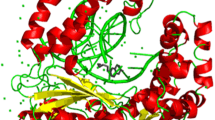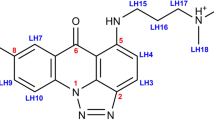Abstract
Cancer is the second leading cause of death worldwide. Drug researchers have encouraged by the growth of cancer incidence and low efficacy of current treatment to discover new drugs. Targeting specific regions of DNA to turn on/off genes has become an interesting research area. We evaluated the interaction of 5-(benzylidene)-1,3-dimethylpyrimidine-2,4,6(1H,3H,5H)-trione derivatives with ctDNA using in vitro and in silico studies. MD simulation indicated that selectivity switched from AT to CG-rich DNA strands when the chloro substitution was moved from meta to para position of the phenyl ring. 4-OH derivative showed similar affinity to AT and CG-rich DNA strand. Quantum mechanics calculation indicated that 4-OH derivative had the highest HOMO energy. The order in HOMO energies was compatible with the absorption titration result that demonstrated the order of Ka as 4-OH > 4-Cl > 3-Cl.
Graphical abstract

Synopsis. 5-(benzylidene)-1,3-dimethylpyrimidine-2,4,6(1H,3H,5H)-trione derivatives could interact with ctDNA. MD simulation indicated that m- and p-chlorophenyl derivatives selectively bind to AT and CG-rich DNA strands respectively. The order in HOMO energies was compatible with absorption titration result that demonstrated the order of Ka as 4-OH > 4-Cl > 3-Cl.






Similar content being viewed by others
References
Bertram J S 2000 The molecular biology of cancer Mol. Aspects Med. 21 167
Khazaei M, Dastan D and Ebadi A 2021 Binding of foeniculum vulgare essential oil and its major compounds to double-stranded DNA: in silico and in vitro studies Food Biosci. 41 100972
Silvestri C and Brodbelt J S 2013 Tandem mass spectrometry for characterization of covalent adducts of DNA with anticancer therapeutics Mass. Spectrom. Rev. 32 247
Ni Y, Lin D and Kokot S 2006 Synchronous fluorescence, UV–visible spectrophotometric, and voltammetric studies of the competitive interaction of bis (1, 10-phenanthroline) copper (II) complex and neutral red with DNA Anal. Biochem. 352 231
Sirajuddin M, Ali S and Badshah A 2013 Drug–DNA interactions and their study by UV–visible, fluorescence spectroscopies and cyclic voltametry J. Photochem. Photobiol. B 124 1
Mei H Y and Barton J K 1986 Chiral probe for A-form helixes of DNA and RNA: tris (tetramethylphenanthroline) ruthenium (II) J. Am. Chem. Soc. 108 7414
Ion G N D, Olaru O T, Nitulescu G, Olaru I I, Tsatsakis A, Burykina T I, et al. 2020 Improving the odds of success in antitumoral drug development using scoring approaches towards heterocyclic scaffolds Oncol. Rep. 44 589
Palmucci J, Mahmudov K T, da Silva M F C G, Marchetti F, Pettinari C, Petrelli D, et al. 2016 DNA and BSA binding, anticancer and antimicrobial properties of Co (II), Co (II/III), Cu (II) and Ag (I) complexes of arylhydrazones of barbituric acid RSC Adv. 6 4237
Borse B N, Shukla S R, Sonawane Y A and Shankerling G S 2013 Synthesis of some novel pyrimidinedione and pyrimidinetrione derivatives by a greener method: study of their antimicrobial activity and photophysical properties Synth. Commun. 43 865
Gao Y, Xie J, Tang R, Yang K, Zhang Y, Chen L and Li H 2019 Identification of a pyrimidinetrione derivative as the potent DprE1 inhibitor by structure-based virtual ligand screening Bioorg. Chem. 85 168
Neumann D M, Cammarata A, Backes G, Palmer G E and Jursic B S 2014 Synthesis and antifungal activity of substituted 2, 4, 6-pyrimidinetrione carbaldehyde hydrazones Bioorg. Med. Chem. 22 813
Reiter L A, Freeman-Cook K D, Jones C S, Martinelli G J, Antipas A S, Berliner M A, et al. 2006 Potent, selective pyrimidinetrione-based inhibitors of MMP-13 Bioorg. Med. Chem. Lett. 16 5822
Deb M L and Bhuyan P J 2005 Uncatalysed knoevenagel condensation in aqueous medium at room temperature Tetrahedron Lett. 46 6453
Heinemann U, Alings C and Bansal M 1992 Double helix conformation, groove dimensions and ligand binding potential of a G/C stretch in B-DNA EMBO J. 11 1931
Coll M, Aymami J, Van der Marel G A, Van Boom J H, Rich A and Wang A H J 1989 Molecular structure of the netropsin-d (CGCGATATCGCG) complex: DNA conformation in an alternating AT segment Biochemistry 28 310
Neese F 2012 The ORCA program system Wiley Interdiscip. Rev. Comput. Mol. Sci. 2 73
Weigend F and Ahlrichs R 2005 Balanced basis sets of split valence, triple zeta valence and quadruple zeta valence quality for H to Rn: design and assessment of accuracy Phys. Chem. Chem. Phys. 7 3297
Grimme S, Ehrlich S and Goerigk L 2011 Effect of the damping function in dispersion corrected density functional theory J. Comput. Chem. 32 1456
Nikkhoo A R, Miri R, Arianpour N, Firuzi O, Ebadi A and Salarian A A 2014 Cytotoxic activity assessment and C-Src tyrosine kinase docking simulation of thieno[2,3-b] pyridine-based derivatives Med. Chem. Res. 23 1225
Morris G M, Huey R, Lindstrom W, Sanner M F, Belew R K, Goodsell D S and Olson A J 2009 AutoDock4 and AutoDockTools4: automated docking with selective receptor flexibility J. Comput. Chem. 30 2785
Van Der Spoel D, Lindahl E, Hess B, Groenhof G, Mark A E and Berendsen H J C 2005 GROMACS: fast, flexible, and free J. Comput. Chem. 26 1701
Wang J, Wolf R M, Caldwell J W, Kollman P A and Case D A 2004 Development and testing of a general amber force field J. Comput. Chem. 25 1157
Jakalian A, Jack D B and Bayly C I 2002 Fast, efficient generation of high-quality atomic charges. AM1-BCC model: II. Parameterization and validation J. Comput. Chem. 23 1623
Hess B, Bekker H, Berendsen H J C and Fraaije J G E M 1997 LINCS: a linear constraint solver for molecular simulations J. Comput. Chem. 18 1463
Darden T, York D and Pedersen L 1993 Particle mesh ewald: an N⋅ Log (N) method for Ewald sums in large systems J. Chem. Phys. 98 10089
Fukui K 1982 The role of frontier orbitals in chemical reactions (nobel lecture) Angew. Chem. Int. Ed. Eng. 21 801
Efron B 1992 Bootstrap Methods: Another Look at the Jackknife. In Breakthroughs in statistics (New York: Springer) pp. 569–593
Acknowledgements
We are grateful to the Vice-chancellor for Research and Technology, Hamadan University of Medical Sciences for financial support of this work (No. 9504222158).
Author information
Authors and Affiliations
Corresponding author
Ethics declarations
Conflict of interest
The authors declared that there is no conflict of interest.
Supplementary Information
Below is the link to the electronic supplementary material.
Rights and permissions
About this article
Cite this article
Dastan, D., Ebadi, A. Effect of substitution on the binding affinity of 5-bezylidenebarbituric acid derivatives to ctDNA: in silico and in vitro studies. J Chem Sci 134, 20 (2022). https://doi.org/10.1007/s12039-021-02007-z
Received:
Revised:
Accepted:
Published:
DOI: https://doi.org/10.1007/s12039-021-02007-z




